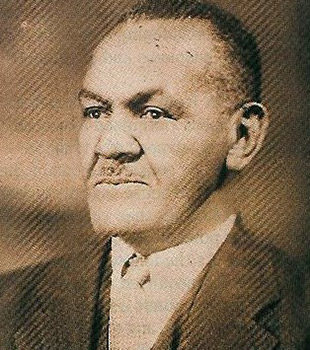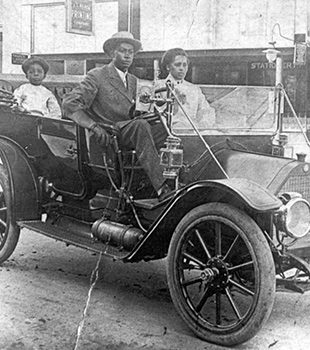
Andrew Jackson Smitherman was born in Alabama on December 27st, 1883 and moved to Indian Territory with his family when he was a child. He completed secondary school in Iowa, then attended the University of Kansas and Northwestern University before finally earning a law degree from LaSalle University Extension School in Boston and Chicago. After returning to Oklahoma, having discovered an interest in journalism, he found a way to combine both of his passions when he became a law clerk for attorney W.H. Twine, who also owned the Muskogee Cimiter. He would eventually convince Twine to let him run the Cimiter. At the time, almost all African-Americans voted Republican in every election. Smitherman considered that they weren’t getting nearly enough in return and that Democrats didn’t even attempt lobbying to black people because they were convinced they were lost votes. He decided that the solution was to diversify the black vote so both parties would have to really work for it. He became a Democrat in 1911 and left the Cimiter to start his own newspaper, the Muskogee Star. From the Star he spread Democratic ideas and promoted defense against racial violence by self-reliance and militant action. Smitherman’s determination and integrity were enough to gain him the respect of not only the black community, but some white people in power as well. When President Woodrow Wilson was scheduled to visit Oklahoma in 1919, governor James B.A. Robertson chose Simtherman as one of the delegates to receive him. In 1920, after a series of lynchings, Robertson organized an interracial conference and Smitherman was one of the African-American leaders selected to participate.
After the Tulsa Race Massacre, Smitherman was one of the 60 black Greenwood residents indicted for riot-related offenses. Both he and his brother John, a sheriff’s deputy, were put in jail. Smitherman posted bond and left Tulsa. Now a fugitive and unable to return to Oklahoma, he kept out of the public eye for a year, living in Boston and Springfield, Massachusetts for a few years before movin to Buffalo, New York, in 1925. There, he worked for other African-American newspapers before founding the Buffalo Star in 1932. From the Buffao Star he would continue his leadership, civic contributions and hard work. He died at his desk, writing his autobiography, 1961. The indictment against him was dismissed in 2007.

Simon Barry was born in Mississippi on July 6th, 1890. Not much is known about his early life besides the fact that he taught auto mechanics at West Tennessee College before moving to Tulsa. It’s also not clear exactly why or when he moved to Tulsa,, but there are records of him being there in 1915. For example, he married Alma Pitman in Tulsa, on December 19th that year20. At the time, taxi services in Tulsa were only available for white people. In response, Berry used his own Model T convertible and started a jitney service for a nickel a ride. A jitney was a car that you hailed, told the driver where you wanted to go and got in with other passengers. Berry would take as many passengers as he could stuff in or have hang on20. Bsides his jitney service, he also built a mechanic garage where he trained black mechanics. Simon Berry was also one of the entrepreneurs that stayed in Tulsa and helped rebuild Greenwood after the Riot Massacre. Berry got his pilot’s license and bought an open-cockpit biplane in 1925, after which he and business partner James Lee Northington launched a charter airline service. He bought some buses and started a bus line, getting a license to operate the franchise in 1928. In 1926 he purchased 13 acres of land and transformed them into a park that included a rose garden, swimming pool, dance hall and picnic grounds. He gifted the park to the city of Tulsa in 1929. There isn’t much information about Simon Berry after the late 1920s and is estimated to have passed away sometime in 1941.

John the Baptist Stradford was born in Kentucky on September 10th, 1861. There aren’t many details about JB’s early years, but it is known he graduated from Oberlin College in 1896 and from Indiana Law School in 1899, after which he began practicing law and invested in a hotel in Alexandria, Indiana. When the hotel went out of business in 1900, he started looking for new places to establish businesses and ended up movin to Tulsa. In Tulsa, Stradford quickly established an informal partnership with O.W. Gurley, focusing en real estate and building rental units. JB’s greatest accomplishment was the 54-suite luxiry Stradford Hotel, valued at the time at 75,000 $ (2.5 million $ today)1. It was the largest black-owned hotel in the US at the time and his empire also included rental houses, rooming houses, pool halls, shoeshine parlors and bathhouses. On June 6th, 1921, Stradford became the first person formally charged with “inciting a riot”, with a penalty of life in prison or death. Grabbing some cash, he fled Tulsa and ended up in Chicago with his son, Corneliues Francis Stradford, where they successfully fought against his extradition to Tulsa. Stradford passed away in Chicago in 1935.

John Williams met Tennessee-born Loula in his home state of Mississippi and the couple moved to Tulsa around 1903. John was a top-notch mechanic and was in charge of the Thompson Ice Cream Company’s steam-powered freezing equipment by 1909. He saved enough money to buy Greenwood’s first car in 1911 and was soon working as an auto mechanic for his own car as well as others’. One of the most famous Black Wall Street pictures shows John and Loula posing with their car with their 8-year-old son George in the back seat. By 1912 he was doing so well that he resigned from the ice cream company and opened his own auto repair garage. With the profits from the garage, the couple built a three-story building that housed some offices, apartments, and Loula’s first venture: a confectionery/soda fountain. Williams Confectionery sold ice cream, candy and soon became popular with people of all races and was one of Tulsa’s most popular sites for wedding proposals. Loula’s next business would be the couple’s most ambitious one yet. In 1914, the opened the 750-seat Dreamland Theater, which soon became just as popular as the confectionery. All of their businesses were among those burned down in the Tulsa Race Massacre. The family, however, did still receive some income because Loula owned two other Dreamland theaters by 1921: one in Muskogee and one in Okmulgee. They were able to remain in Tulsa and take an active part in its reconstruction. Both the Williams building and the Dreamland Theater were rebuilt in 1922, barely a year after the riot. Loula fell ill and passed away in 1927; John lived until 1940.
